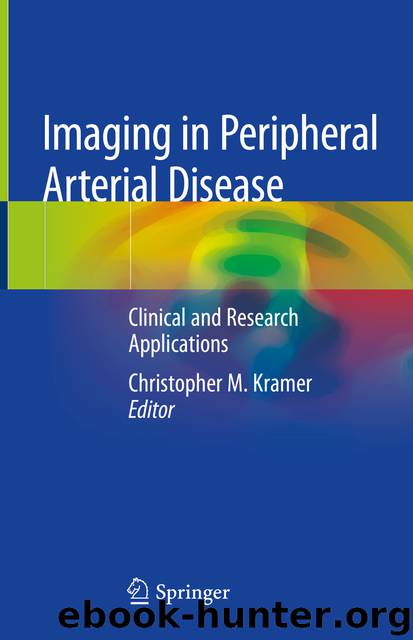Imaging in Peripheral Arterial Disease by Unknown

Author:Unknown
Language: eng
Format: epub
ISBN: 9783030245962
Publisher: Springer International Publishing
Peripheral artery disease
Coronary heart disease
Pathophysiology
Atherothromboembolic
Atherothrombotic
Presentation
Chronic and progressive
Acute
Total occlusions
More prevalent
Less prevalent
Gender
Equal in both males and females
Slight male predominance (55%)
Risk factors
Age, smoking, and diabetes mellitus
Hypertension, lipid disorders
CLI Versus IC
The natural history of untreated critical limb ischemia is largely unknown because in current era of endovascular therapies, almost all patients undergo medical treatment to prolong survival and intervention to attempt limb salvage. A systematic review of studies from 1990 to 2015 found that when followed clinically, the 5-year cumulative incidence of patients with claudication that progressed to CLI is 21% [29]. Patients with CLI who do not undergo revascularization have a 20% mortality rate and a 50% risk of major amputation in 1 year. The majority of patients with IC do not develop CLI; rather CLI may be distinct manifestation of PAD. Various studies have found some key pathophysiological differences between CLI and IC.
A recent study by Ryan and colleagues [30] analyzed gastrocnemius muscle biopsy samples from age-, gender-, and risk factor-matched cohort of 32 healthy adults, 27 patients with IC, and 19 patients with CLI using transcriptome (mRNA) sequencing. It was found that the gene expression profile was strikingly different in CLI tissues or stated differently the patients with PAD but IC were more similar to controls than to PAD but CLI. Mitochondrial respiratory capacity was lower in CLI muscle myofibers despite similar mitochondrial content (number)/density between IC and CLI patients . Mitochondriopathy including reduced mitochondrial oxidative capacity, reduced electron transport system enzyme function, and decreased abundance of mitochondria-associated mRNAs and proteins in patients with CLI may be a target for focused adjuvant therapeutics.
When looking at imaging needs for development of novel therapeutics, it is important to pay attention as to whether differences between CLI and IC patients were examined. MR spectroscopy data which showed dissociation of mitochondrial function and muscle perfusion on patients with IC as will be discussed cannot be generalized to CLI population. Integrated imaging techniques that measure in parallel some of these processes that have been discussed in this chapter will be useful in further evaluation of novel therapies in the clinical trials.
Download
This site does not store any files on its server. We only index and link to content provided by other sites. Please contact the content providers to delete copyright contents if any and email us, we'll remove relevant links or contents immediately.
Men In Love by Nancy Friday(4974)
Everything Happens for a Reason by Kate Bowler(4485)
The Immortal Life of Henrietta Lacks by Rebecca Skloot(4267)
Why We Sleep by Matthew Walker(4198)
The Sports Rules Book by Human Kinetics(4084)
Not a Diet Book by James Smith(3158)
The Emperor of All Maladies: A Biography of Cancer by Siddhartha Mukherjee(2939)
Sapiens and Homo Deus by Yuval Noah Harari(2857)
Day by Elie Wiesel(2601)
Angels in America by Tony Kushner(2397)
Endless Forms Most Beautiful by Sean B. Carroll(2355)
A Burst of Light by Audre Lorde(2354)
Hashimoto's Protocol by Izabella Wentz PharmD(2208)
Dirty Genes by Ben Lynch(2168)
Reservoir 13 by Jon McGregor(2152)
And the Band Played On by Randy Shilts(2023)
Wonder by R J Palacio(1996)
The Immune System Recovery Plan by Susan Blum(1974)
Stretching to Stay Young by Jessica Matthews(1951)
